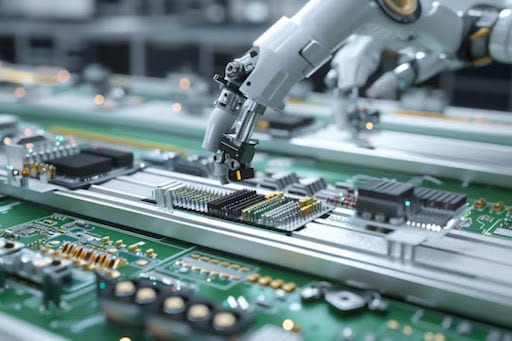
Did you know that the performance and longevity of your favourite gadgets depend heavily on the packaging that protects their internal components?
Yes, the metal packaging in PCB manufacturing plays a critical role in ensuring the reliability of electronics. From shielding against environmental factors to managing heat, metal packaging is indispensable.
Let’s understand the various aspects of metal packaging and how it impacts PCB manufacturing.
What is the Role of Metal Packaging in PCB Manufacturing?
Metal packaging is more than just a protective cover for PCBs; it’s a secret factor in PCB manufacturing.
Imagine a PCB exposed to dust, moisture, and mechanical stress. These factors could easily damage the sensitive components and disrupt functionality without proper packaging. Metal packaging provides a robust barrier against these threats, ensuring the device’s reliability and longevity.
Moreover, metal packaging is crucial for thermal management as electronic components operate; they generate heat.
In PCB manufacturing, material selection for high-temperature environments is essential to prevent overheating, which can lead to failures or reduced device lifespan
Metal packaging excels in this regard, helping to keep the internal components cool and functional.
Types of Metal Packaging Solutions
When it comes to metal packaging, one size does not fit all. Different metals offer unique benefits tailored to specific needs in PCB manufacturing.
-
Aluminum Packaging
Aluminium packaging stands out for its lightweight yet durable nature. It boasts excellent thermal conductivity, which ensures efficient heat dissipation. This makes aluminium packaging ideal for high-performance electronics that generate significant heat.
Additionally, aluminium’s natural resistance to corrosion adds to its appeal, providing long-term durability.
-
Steel Packaging
Steel packaging is the go-to choice for applications with paramount mechanical strength and durability.
Steel offers superior mechanical strength, protecting PCBs from physical damage in harsh environments such as industrial or automotive settings. Its robustness ensures that the PCB remains intact and operational even under significant stress.
-
Copper Packaging
Copper packaging is revered for its exceptional electrical conductivity. This property makes it perfect for applications where signal integrity and electrical performance are critical.
Furthermore, copper’s outstanding thermal conductivity ensures effective heat management, making it a popular choice for high-speed and high-frequency electronics.
-
Hybrid Metal Packaging
Sometimes, a single metal cannot meet all the requirements. Hybrid metal packaging combines the best properties of different metals.
For example, an aluminium-copper hybrid can offer both excellent thermal management and superior electrical conductivity, catering to complex and demanding applications where both properties are essential.
Selection Criteria for Metal Packaging in PCB Manufacturing
Electronics Manufacturing Services ensures that advanced manufacturing techniques are applied effectively, enhancing the quality and reliability of your electronic assemblies.
That’s why choosing the right metal packaging involves evaluating several critical factors to meet specific requirements.
Here’s what you need to consider:
-
Thermal Management
Heat is a significant concern in electronics. Effective thermal management ensures longevity and reliability. Metals like aluminium and copper are excellent at dissipating heat, making them ideal for high-power applications.
When selecting metal packaging, consider the material’s thermal conductivity to maintain optimal operating temperatures.
-
Mechanical Strength and Durability
PCBs in industrial or automotive environments often face physical shocks and stresses. Steel packaging provides the necessary mechanical strength to protect the PCB from these harsh conditions.
Assess the environment in which the PCB will operate and choose a material that offers adequate protection against physical damage.
-
Corrosion Resistance
Environmental factors can lead to corrosion, compromising the performance and lifespan of your PCB. Metals like aluminium are naturally resistant to corrosion, making them suitable for humid or corrosive environments.
If corrosion resistance is a priority, select materials that can withstand these harsh conditions without degrading.
-
Electrical Conductivity
Electrical conductivity is crucial for applications requiring high-speed and high-frequency signal transmission. Copper is the preferred choice here due to its excellent signal integrity.
If maintaining precise electrical performance is essential, opt for a metal that minimizes resistance and signal loss.
-
Cost Considerations
Budget constraints are always a factor in manufacturing. While copper offers sustainable properties, it’s also more expensive. Aluminum provides a cost-effective balance of thermal and mechanical properties.
Weigh the benefits against the costs to find a solution that meets both performance and budgetary requirements.
Manufacturing Techniques and Technologies
The effectiveness of metal packaging during electronic assembly is not only about material selection but also the manufacturing process.
Here are some key techniques used in the industry:
-
Metal Stamping and Forming
This technique involves cutting and shaping metal sheets into the desired form. It’s highly efficient and suitable for mass production, ensuring consistency and precision.
Metal stamping and forming are often used to create intricate designs and features on metal packaging, providing structural integrity and aesthetic appeal.
-
Die Casting and Molding
Die casting involves forcing molten metal into a mold cavity, creating complex shapes with high accuracy. This method is ideal for producing components with detailed geometries and smooth surfaces.
Die casting is widely used for aluminium and zinc packaging, offering a balance of strength and lightweight properties.
-
Surface Finishing and Coating
The surface of metal packaging can be treated to enhance its properties. Surface finishing techniques like anodizing, painting, or electroplating improve corrosion resistance, aesthetic appeal, and durability.
Surface finishing and coating can also provide additional insulation or thermal management benefits tailored to specific application needs.
Hence, you can ensure your PCBs are well-protected and optimised for performance by understanding the types of metal packaging solutions, evaluating selection criteria, and leveraging advanced manufacturing techniques.
Conclusion
The choice of metal packaging in electronic assembly can make or break your device’s functionality.
Electronics Manufacturing Services providers play a crucial role in implementing these PCB manufacturing techniques, from metal stamping to surface finishing, ensuring that each component meets the highest quality and performance standards.
Metal packaging works silently behind the scenes, keeping components running smoothly and efficiently. The right packaging choice protects and enhances the longevity and performance of intricate electronics.
